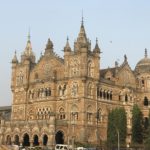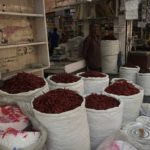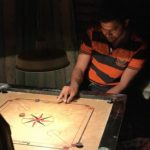Dubai to Mumbai – 1928 km (air)
& 38540 Fit Bit steps
We were very fortunate to be able to spend a few days in Mumbai with Brian and Anne. We so appreciated being introduced to their friends and colleagues who graciously welcomed us and included us in invitations. In addition to meeting some wonderful people and enjoying excellent meals together, it helped us to begin to develop some elementary perspectives of this complicated city and its more than 21 million residents. Our strolls and long drives through the city and beyond also gave us a glimpse of both better and poorer neighbourhoods. The contrasts are huge, and often jarring. For example, across the wall from youngsters playing cricket in the club of an apartment complex where we stayed, is a street market where we saw stalls hurriedly packed up or hidden when tax inspectors suddenly arrived. At least one seller lost all his goods, including tables. We understood that the inspectors personally profit from such raids. One evening, we were privileged to be hosted for dinner by Brian and Anne’s driver from their sojourn here. He and his family are building a temple with their community to commemorate a Hindu saint, this in the middle of a vast area called the Dharvari “slum”. It has an estimated population of 1 million people in 2.2 sq km. Housing ranges from crude shelters to apartment blocks with flush toilets. The teeming streets and alleyways are home to a multitude of small businesses which are said to generate $750M a year. There are drainage ditches full of waste, but we also saw streets in poor neighborhoods swept clean and the garbage picked up and recycled. These areas are not far from more affluent areas, such as those close to Marine Drive. There, we strolled along the waterfront at sunset before going to the National Centre for the Performing Arts to see a play about contemporary life in the city.
Just outside the city, in Sanjay Ghandi National Park, we explored the Kanheri caves, an extensive system of monastic cells and temples intricately carved out of the rock, dating back to the 1st Century BC. The park is said to be the lungs of the city as it purifies much of the air pollution of the city, although our experience suggests that that is a major challenge!
Other highlights:
– Chhatrapati Shrivaji Terminus (train station) – UNESCO World Heritage Site;
– Babu Amichand Panalal Adishwarji Jain Temple;
– Chhatrapati Shrivaji Maharaj Vastu Sangrahalaya Museum (built to commemorate the visit of the Prince of Wales in 1922) – a fine building and one of the premier art and history museums in India. Our brief visit only gave us an introduction – we will try to return when we come back to Mumbai at the end of February;
– Breakfast treats of samosas and docla brought to us by the very sweet Reshma.
Wildlife notes: chital (spotted deer)












